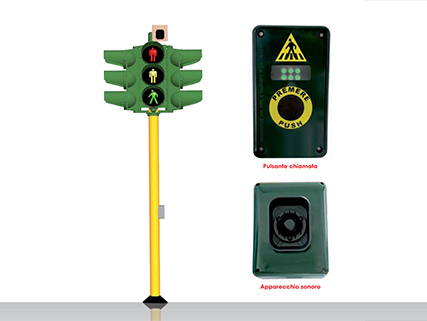According to Art. 6.4 of D.P.R. (Presidential Decree) 24 July 1966 no. 503, of the Italian Highway Code Art. 41 comma 5 and in compliance with the relevant legislation for implementation of Art. 162 comma 5
APPLICABLE LAW
The equipment complies with the following laws
IEC 214-7 proposal
Law 447 of 26-10-1995 and related
D.P.C.M. – 14 November 97
GENERAL CHARACTERISTICS
The equipment has two parts:
- the request-to-cross device consists of: a button for the normally sighted-persone’s request for crossing, a light signal to confirm that the request has been accepted, a request button for visually-impaired persons, and an audio signal to confirm for visually impaired persons that the request has been accepted;
- the safe-to-cross acoustic device consists of:
a microprocessor controller, an ambient noise sensor, an audio transducer which emits the safe-to-cross signal.
The two parts are functionally and electrically integrated and, as required by law, cannot function disconnected one from the other.
Each part is mounted in its own housing, one suitable for mounting at the top of the traffic light pole near the lights themselves, the other, for the request to cross, on the pole at a convenient height.
FUNCTIONAL CHARACTERISTICS
The pedestrian crossing, as required by law, must have on both sides of the road a request-to-cross and a safe-to-cross device, connected in such a way that, when crossing is requested, the safe-to-cross signal is emitted on both sides of the road.
REQUEST DEVICE
The request device is designed for two types of users, normally-sighted and visually impaired pedestrians. The request inserted by normally-sighted persons is signalled to the traffic light controller, which initiates the changing of the lights and also sends a feedback signal which lights up the signal to show that the request to cross has been accepted.
The request by visually impaired persons is signalled to the acoustic device mounted on the same pole. The request is memorised, a “request accepted” signal is sent back to the request device which emits an acoustic signal as per paragraph 4.2. of IEC standards 214-7; the request device mounted on the opposite side of the road sends the request to its corresponding acoustic device; the traffic light regulator then proceeds as for a normally sighted-person’s request.
In particular when the request by a visually-impaired person is inserted when the visual signal says it’s safe to cross, the system stores this request until it can be inserted in a new crossing cycle.
ACOUSTIC DEVICE
The acoustic device emits 60 beeps a minute when it’s safe to cross (green visual signal) and 120 beeps a minute during the amber phase. The unit beeps only when there is a crossing request and the sound volume can be regulated, for the whole of the duration of the acoustic signal, so that it is regulated relative to the background noise level present during the duration of the acoustic signal.
The acoustic signal is tied in to the green phase of the traffic lights, so that is a request to cross is inserted when the lights are on green, the request will be satisfied during the successive traffic light cycle.
For every crossing request received, provided it is possible to satisfy the request, the unit sends a signal to the request device in order that the audio “request accepted” signal is activated, as well as sending a crossing request to the traffic light controller.
SAFETY REQUEST DEVICE
The request device does not emit the “request accepted” sound if the acoustic device cannot comply with the request.
ACOUSTIC DEVICE
The device is connected in parallel with the traffic lights themselves, so that the sound and light signals are always synchronized.
The acoustic signal is delayed compared to the green safe-to-cross signal to allow safety checks.
The acoustic signal doesn’t sound if: there is a power failure (automatic, since the acoustic signal is connected in parallel with the green and amber lights of the pedestrian crossing) voltage to red pedestrian crossing light above the legal maximum for a signal which, for safety, must be OFF (50 V) voltage to green and amber pedestrian crossing lights below the legal minimum for a signal which, for safety, must be ON (160 V) flashing lights


